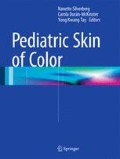Abstract
Acquired diffuse hyperpigmentation in children secondary to metabolic disorders can be divided into nutritional diseases, endocrinological disorders, and metabolic causes. Although pigmentation is categorized as diffuse, it is often accentuated in some areas. Adequate approach of diffuse hyperpigmentation may lead to the early diagnosis of a specific disease. The initial and most prominent sign can be in the skin and thus the dermatologist is the first physician consulted.
Access this chapter
Tax calculation will be finalised at checkout
Purchases are for personal use only
References
Hess AF, Meyers VC. Carotenemia. A new clinical picture. JAMA. 1919;73:1743–5.
Venkatesh KS, Campbell-Davidson D, Isherwood D. Carotenemia in infancy and its association with prevalent feeding practices. Pediatr Dermatol. 2006;23:571–3.
Congdon PJ, Kelleher J, Edwards P, Littlewood JM. Benign carotenaemia in children. Arch Dis Child. 1981;56:292–4.
Lascari AD. Carotenemia: a review. Clin Pediatr. 1981;20:25–9.
Svensson A, Vahlquist A. Metabolic carotenemia and carotenoderma in a child. Acta Derm Venereol. 1995;75:70–1.
Loukili NH, Noel E, Blaison G, Goichot B, Kaltenbach G, Rondeau M, Andrès E. Update of pernicious anemia. A retrospective study of 49 cases. Rev Med Interne. 2004;25:556–61.
Baker SJ, Ignatius M, Johnson S, Vaish SK. Pigmentation and vitamin B12 deficiency. Br Med J. 1963;2:1205.
Cherqaoui R, Husain M, Madduri S, Okolie P, Nunlee-Bland G, Williams J. A reversible cause of skin hyperpigmentation and postural hypotension. Case Rep Hematol. 2013;2013:680459.
Kannan R. Cutaneous lesions and vitamin B12 deficiency. An often-forgotten link. Can Fam Physician. 2008;54:529–32.
Aaron S, Kumar S, Vijayan J, Jacob J, Alexander M, Gnanamuthu C. Clinical and laboratory features and response to treatment in patients presenting with vitamin B12 deficiency-related neurological syndromes. Neurol India. 2005;53:55–8.
Feingold KR, Elias PM. Endocrine-skin interactions. Cutaneous manifestations of pituitary disease, thyroid disease, calcium disorders, and diabetes. J Am Acad Dermatol. 1987;17:921–40.
Jabbour SA. Cutaneous manifestations of endocrine disorders: a guide for dermatologists. Am J Clin Dermatol. 2003;4:315–31.
De Majo SF, Onativia A. Acromegaly and gigantism in a boy: comparison with three overgrown non-acromegalic children. J Pediatr. 1960;57:382–90.
Spence HJ, Trias EP, Raiti S. Acromegaly in a nine and a half year old boy. Pituitary function studies before and after surgery. Am J Dis Child. 1972;123:504–6.
Laureti S, Vecchi L, Santeusanio F, Falorni A. Is the prevalence of Addison’s disease under estimated? J Clin Endocrinol Metab. 1999;84:1762.
Norup J. Addison’s disease-clinical studies. A report of 108 cases. Acta Endocrinol. 1974;76:127.
Simm PJ, McDonnell CM, Zacharin MR. Primary adrenal insufficiency in childhood and adolescence: advances in diagnosis and management. J Paediatr Child Health. 2004;40:596–9.
Grant DB, Barnes ND, Moncrieff MW, Savage MO. Clinical presentation, growth and pubertal development in Addison’s disease. Arch Dis Child. 1985;60:925–8.
Shulman DI, Palmert MR, Kemp SF. Adrenal insufficiency: still a cause of morbidity and death in childhood. Pediatrics. 2007;119:e484–94.
Kong AS, Vanderbloemen L, Skipper B, Leggott J, Sebesta E, Glew R, Burge MR. Acanthosis nigricans predicts the clustering of metabolic syndrome components in Hispanic elementary school-aged children. J Pediatr Endocrinol Metab. 2012;25:1095–102.
Stuart CA, Pate CJ, Peters EJ. Prevalence of acanthosis nigricans in an unselected population. Am J Med. 1989;87:269–72.
Longo N, Wang Y, Smith SA, Langley SD, DiMeglio LA, Giannelle-Neto D. Genotype-phenotype correlation in inherited severe insulin resistance. Hum Mol Genet. 2002;11:1465–75.
Sinha S, Schwartz RA. Juvenile Acanthosis nigricans. J Am Acad Dermatol. 2007;57:502–8.
Schwartz RA. Acanthosis nigricans. J Am Acad Dermatol. 1994;31:1.
Crownover BK, Covey CJ. Hereditary hemochromatosis. Am Fam Physician. 2013;87:183–90.
Barton JC, Rao SU, Pereira NM, Gelbart T, Beutler E, Rivers CA, Acton RT. Juvenile hemochromatosis in the southeastern United States: a report of seven cases in two kinships. Blood Cells Mol Dis. 2002;29:104–15.
Cheurant-Breton J, Simon M, Bourel M, Ferrand B. Cutaneous manifestations of idiopathic hemochromatosis. Arch Dermatol. 1977;113:161.
Moretti D, van Doorn GM, Swinkels DW, Melse-Boonstra A. Relevance of dietary iron intake and bioavailability in the management of HFE hemochromatosis: a systematic review. Am J Clin Nutr. 2013;98:468–79.
Perdrup A, Poulsen H. Hemochromatosis and vitiligo. Arch Dermatol. 1964;90:34.
Nadakkavukaran IM, Gan EK, Olynyk JK. Screening for hereditary hemochromatosis. Pathology. 2012;44:148–52.
Szalay F. Hemochromatosis: one form of iron-overload diseases. Orv Hetil. 2013;154:1156–64.
Author information
Authors and Affiliations
Corresponding author
Editor information
Editors and Affiliations
Rights and permissions
Copyright information
© 2015 Springer Science+Business Media New York
About this chapter
Cite this chapter
Orozco-Covarrubias, L., Sáez-de-Ocariz, M. (2015). Metabolic Hyperpigmentation: Carotenemia, Pernicious Anemia, Acromegaly, Addison’s Disease, Diabetes mellitus, and Hemochromatosis. In: Silverberg, N., Durán-McKinster, C., Tay, YK. (eds) Pediatric Skin of Color. Springer, New York, NY. https://doi.org/10.1007/978-1-4614-6654-3_13
Download citation
DOI: https://doi.org/10.1007/978-1-4614-6654-3_13
Published:
Publisher Name: Springer, New York, NY
Print ISBN: 978-1-4614-6653-6
Online ISBN: 978-1-4614-6654-3
eBook Packages: MedicineMedicine (R0)

